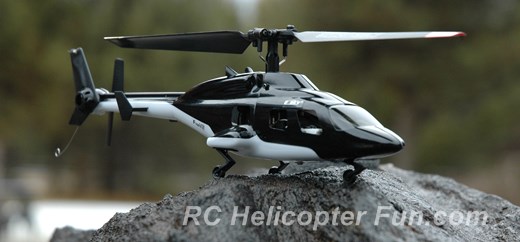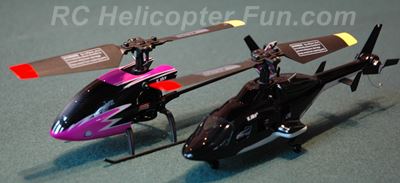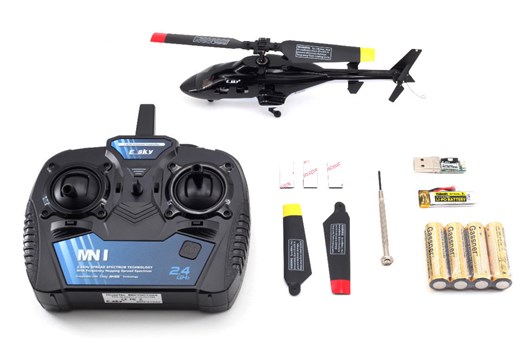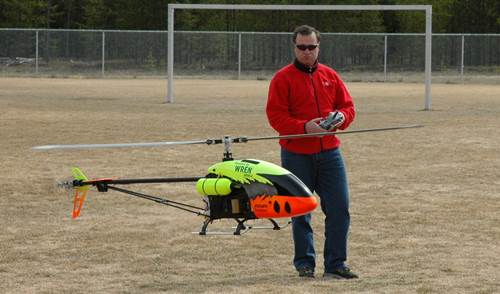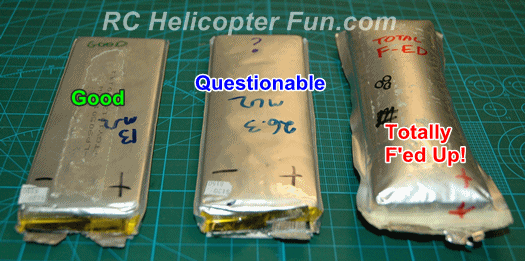Esky F150 - Micro Sized Scale Bell 222 / Airwolf Fun
by John Salt - Updated November 2023
The Esky F150 V2 has been replaced with the Esky F150 V3. The helicopter fuselage and mechanics are the same, the V3 has some changes to the electronics and RF protocol.
As a Scale RC helicopter enthusiast and Bell 222 / Airwolf fan, I can't recall getting this excited over a simple fixed pitch ready to fly micro RC heli in a long time. This of course is not your average low cost micro FP heli.
With the Bell 222 fuselage and black/white Airwolf color scheme, this little heli looks fantastic. Question... Is it all show with little go, or does it actually fly well while being as stable and easy to pilot as advertised?
That's what we're dying to find out! So let's get to it...
The shiny scale exterior of the F150 V2/V3 looks great with nice details; but what's inside this little micro is much more important.
Esky's F150 V2/V3, basically uses the same mechanics and electronics as their very popular, robust, and easy to fly pod & boom 150 V2.
The 150 V2 is an amazing little heli, and to fully appreciate the F (fuselage) version, you really should know more about the standard 150 V2 version.
I've already done a full review on the 150 V2 so I encourage you to look at that page to learn what makes it tick inside, and what makes it so stable and easy to fly. No sense writing the exact same information on this page.
That review page covers the mechanics, electronics, radio, and battery options in detail. This page will cover specifics on the F150 V2 version along with flight performance thoughts since these two micro RC helicopters do comparatively fly different.
Before getting to all that, here's a video I made going over the Esky F150 V2/V3 which you may be interested in watching before diving deeper into this neat little scale helicopter.
Esky F150 Fuselage
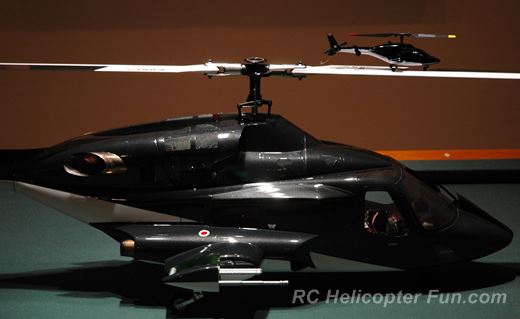 Esky's 70 Size Airwolf With FunKey's 600 Size Airwolf
Esky's 70 Size Airwolf With FunKey's 600 Size AirwolfIf you're into size comparisons, the little 70 size F150 is most certainly a micro, and when viewed along side a 600 size machine, that's obvious.
What isn't as obvious is that the Esky F150 is not a true Airwolf body style even though you see it marketed as a micro Airwolf over and over again. The fuselage / body is an unmodified Bell 222, with the Airwolf color scheme only.
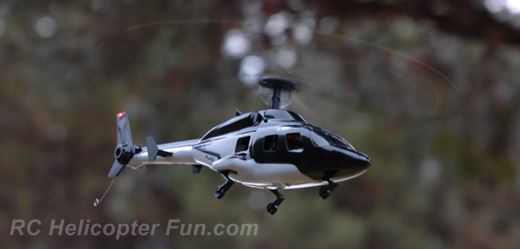 The Esky F150 Is A Bell 222 With Airwolf Color Scheme
The Esky F150 Is A Bell 222 With Airwolf Color SchemeAs you can see, there are no turbo jet enclosures on the wiglets, no raised nose cowling, and the rear windows haven't be covered up by surveillance pods. The true Airwolf is also not black, but rather a shade of dark metallic grey; I think we can overlook that as a very minor detail miss.
Other than those "Airwolf defining omissions", the overall unmodified Bell 222 details are pretty decent. The landing gear looks not half bad (no, they don't actually retract), and the body shape is fairly accurate given the small scale size having to fit around the mechanics correctly.
The exhaust outlets are about the only standout scale Bell 222 miss, being placed on the top of the doghouse like a Bell 206's instead of the sides. Perhaps the reason for the upper placement was to keep both exhaust outlets a little more protected from crash damage?
What is very true to scale, and something I can't even say about my Funkey Airwolf, is the tail rotor is on the correct side of the boom (left side), and the main rotor turns the same direction as full size Bell 222s (CCW when viewed from above). Most RC helicopters have right mounted tail rotors and CW rotating main rotors including the pod & boom 150 V2 version.
This is a good segue into a common question I've already been getting asked...
"Can I fit the Esky F150 fuselage onto my stock 150 V2/V3 mechanics?" pods
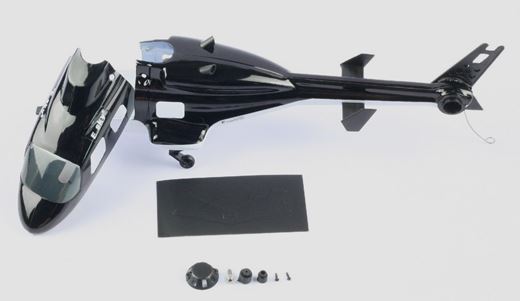 Esky F150 Fuselage Part # ESKY007328
Esky F150 Fuselage Part # ESKY007328I don't like to say anything is impossible in this hobby, because if you are willing to throw enough resources, (time & money) at the problem, you can usually get almost anything to work.
With that said, you would have to spend a lot of time & money to get your stock pod & boom 150 to work with the fuselage. It would be less costly to just get the RTF F150 V2/V3 heli.
Because of the opposite tail rotor placement and main rotor rotation, there are a few costly component differences between the two helicopters. This is confirmed by different part numbers and some simple observations.
The main and tail motors are different, the 5 in 1 CC3D control unit is different, and the blades are different (tail & main). You would even have to get a new frame because the side mounting pads for the fuselage, bottom mounting spacer, and tail motor wire clip aren't offered as separate items, they only come with the F150 specific frame.
Those components combined, along with the fuselage cost about the same as the full Esky F150 V2/V3 RTF package.
The items you could keep using would be the rotor head, swashplate, main gear, pushrods, servo links, and linear servo assembly. The radio as well of course.
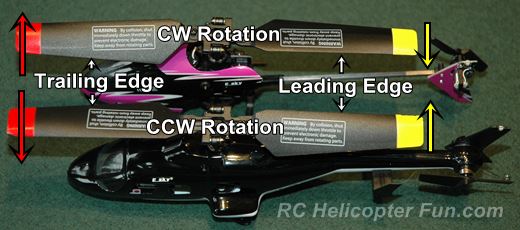 Different Blades Are used on the Esky F150 and 150
Different Blades Are used on the Esky F150 and 150Now consider your time taking all that apart on your F150, and fitting all the new stuff, and hoping it all works correctly afterward. Just not worth it. Better to have both helicopters :-)
As for removing the mechanics out of the Esky F150 V2 / V3 fuselage for repairs or maintenance, that's fairly easy. I quickly went over it in the video, but thought a few more photos would also help you understand the process a little better...
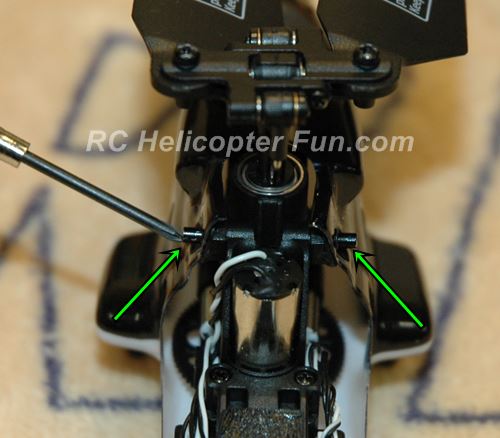 Step 1: Unscrew Both Fuselage Side Retaining Pins
Step 1: Unscrew Both Fuselage Side Retaining Pins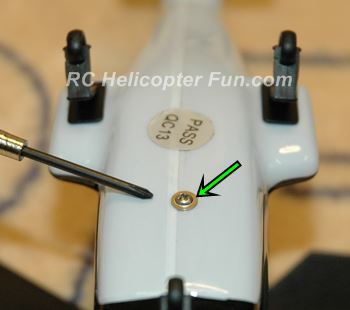 Step 2: Remove Fuselage Belly Screw
Step 2: Remove Fuselage Belly Screw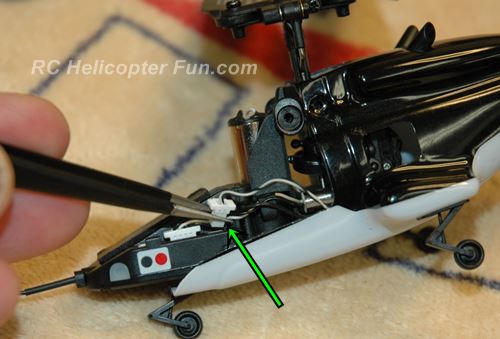 Step 3: Unplug tail motor plug and carefully unclip wiring from frame clips.
Step 3: Unplug tail motor plug and carefully unclip wiring from frame clips.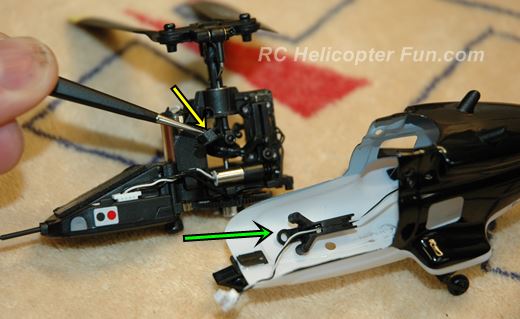 Step 4: Mechanics Out
Step 4: Mechanics OutShown above are the mechanics removed from the F150 fuselage. The green arrow is pointing to the tail wire clip which is just snapped onto the back of the frame. The yellow arrow is pointing to one of the special angled fuselage side spacers that is not on the pod & boom 150 V2.
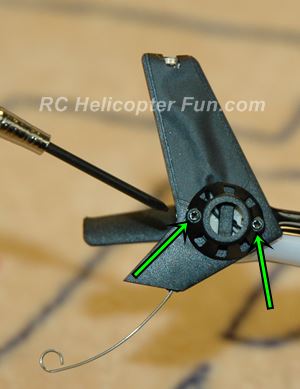 Step 5: Removing the tail rotor motor
Step 5: Removing the tail rotor motorGetting the tail motor out if you ever have to replace it is the hardest task.
First you'll need to remove the plastic cover on the right side of the tail fin (two tiny Phillips screws).
Next you'll have to peel the black fin covering away on both sides to expose the wiring so it, along with the motor can be removed.
The motor is just held in place by friction and is easily pushed out the left side of the boom. The motor doesn't have to be glued into the boom since the right thrust from the tail rotor is always trying to push the motor into its boom mount.
Fitting all the components back into the Esky F150 V2 fuselage is done in the reverse order.
Flying The Esky F150 V2 / V3
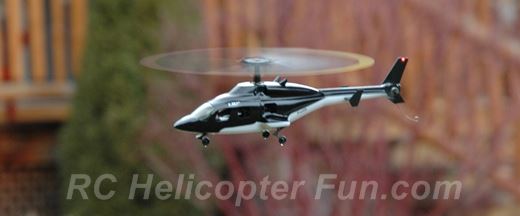
Just like the pod & boom 150 V2 version, the fuselage version is stable in a hover and has very good self leveling characteristics as shown in the video.
In fact, and as I also mentioned in the video, mine was actually more stable while hovering likely due to the slight weight increase over the pod & boom version. Hands off hovering stability is excellent!
The down side of that weight increase is of course less flight time. I was getting about 4 minutes tops when the green LED started flashing indicating the LiPo was getting low.
Flying outdoors more aggressively, 3:30 was about the average. Pretty poor for a single rotor fixed pitch micro, so that good looking scale fuselage comes with a time penalty. Nothing we didn't expect of course...
While on the topic of LiPo's, I have to again mention that weird double sided tape battery mounting method that I pointed out in the video. Honestly, WTH way is that to mount a LiPo pack?
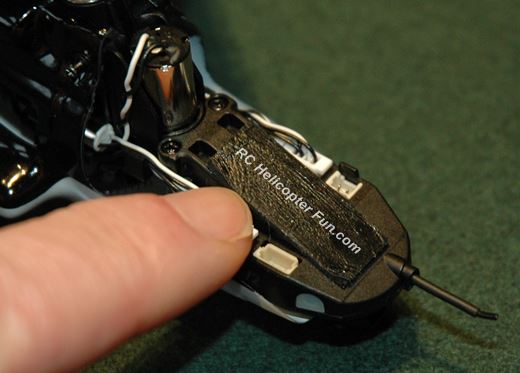 A Sticky Situation?!
A Sticky Situation?!With that said, this "reusable" double sided tape mounting method is working fine.
Provided you don't get dust, dirt, or finger oil on it, the "stick factor" is holding up.
Using Velcro on the top of the LiPo and top of the tray as I mention in the video allowing front nose clearance, will be how I deal with this issue once I've used up all my reusable double sided tape pads that came with the kit.
There is no question, this is a harder fixed pitch micro to fly than the 150 V2 pod & boom version; and I would not recommend it as a "first" single rotor micro unless you've flown something before like a micro coaxial or micro quad-rotor.
Scale details are more fragile and mistakes are less forgiving. The replacement F150 Bell 222 fuselage (part # ESKY007328) is inexpensive however (about $10 USD), if/when you do damage it.
When I say harder to fly, I'm naturally referencing that in comparison with the very easy to fly 150 V2. This little scale micro is also easy to fly in the grand scheme of RC single rotor RC helicopters. Allowing you to get some stress free scale heli flying fun when you can't venture outdoors with your larger scale machines.
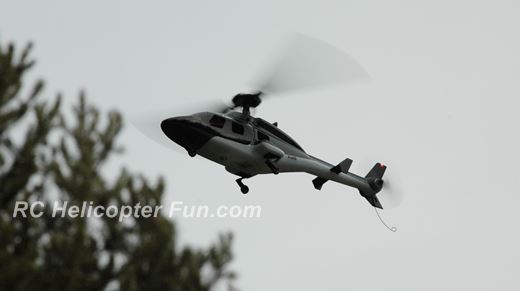
Some of the odd flight characteristics include a very non-linear, almost binary (stop-go) control response.
By that I mean there is an abundance of deadband around mid stick cyclic and tail rotor, and then rather abrupt heli response. This gives the Esky F150 V2 / V3 a very artificial feel that is very different from the fluid like behavior most of expect from our RC helicopters. This is where the CC3D really shows it's quad-rotor roots; and since I dislike flying quads so much, I'm naturally projecting my subjective bias.
You can now bind the eSky F150 V2 / V3 to any OpenTX computerized radio with a multi-protocol module (internal or external) now that Multi-Protocol supports eSky's F150's new protocol. You can totally eliminate that built in dead-band by using dead band eliminating curves on your three primary control channels (pitch, roll, yaw). Below is an update video I made on this exact process.
Like the pod & boom version and every other little fixed pitch micro, the Esky F150 suffers from ballooning when it starts moving fast and is even more susceptible to wind because it has more surface area for the wind to act against. Even very light breezes will push it sideways easily. This really is an indoor or dead calm day flier. Even with the dual rates turned off outdoors, it's a fight to stay in control when a breeze picks up.
As shown in the video, there is a very pronounced left lean caused by the right tail rotor translating tendency (TRTT). More tail rotor induced lean than I've ever seen on any single rotor RC helicopter before. I honestly don't understand why it's so aggressive?
With more weight hanging under the rotor disc, the TRTT induced lean should be less than the Pod & Boom version, but it's not. This can only mean the thrust off the tail rotor is substantial in relation to overall heli mass.
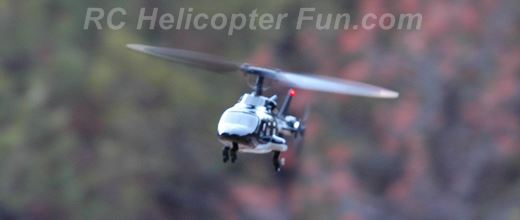 Heavy Left Lean Due To Right Tail Rotor Translating Tendency
Heavy Left Lean Due To Right Tail Rotor Translating TendencyThat excessive left lean looks funny, and causes some odd behavior.
As I demonstrated in the video, when performing slow right pirouettes, the Esky F150 actually starts flying a slow backwards CW circle.
Slow left pirouettes are no issue and fast right pirouettes don't allow enough time for the F150 to enter into the slow backward circuit. In other words, as long as you pirouette fast enough, you won't notice it.
The excessive left lean also prevents the little micro from performing nice coordinated right banking turns. Left banking turns on the other hand are simple since you don't need to hold in any left cyclic to induce the bank - it's already there.
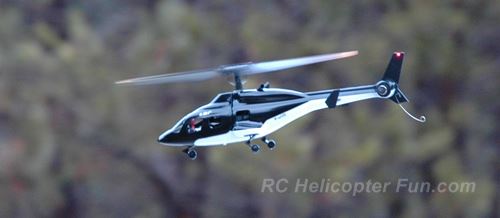
Another interesting characteristic is the F150 V2 "crabs" or tracks sightly right once it starts flying forward at a moderate pace. I contribute this to the tail rotor efficiency increasing as you start moving your F150 faster into clean air. Thus the right thrust from it increases slightly causing the heli to track to the right.
Holding in a little bit of left cyclic to compensate works well, but again with all the deadband coupled to the non linear stick response, it takes a fair amount of fineness to hold in a small enough amount.
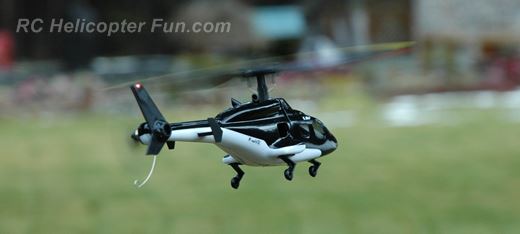 I Love This Rear 3/4 View Of The F150
I Love This Rear 3/4 View Of The F150With all that said, this is still an amazing little micro scale heli and for $70 bucks, I'm amazed it can fly as well as it can and be as stable as it is.
If you enjoy flying scale RC helicopters even half as much as I do, it's easy to look past some of these odd flight characteristic once you see just how good the Esky F150 V2 / V3 looks flying around the yard or inside the living room.
I don't think it would be a far stretch to say it's the best looking micro scale single rotor RC helicopter on the market right now; then again, I'm partial to Bell 222's - always have been.
Final Thoughts
The Esky F150 V2/V3 for the low cost, represents great value in a micro RC helicopter. The odd flight characteristic, fight time compromise, and fragile scale details are not for everyone however.
If you are looking for the better flying experience, stick with the pod & boom 150 V2 version.
The F150 V2 / V3 on the other hand is for scale or Airwolf enthusiasts only in my opinion. We can most likely look past the compromises when we appreciate how fun and unique this product is; in addition to the fact we can now fly a good looking scale RC heli in our home or at the office.
Who said practical and fun have share the same stage. And honestly, is there really anything practical about scale RC helicopters in any size?
Nope, we fly and enjoy them because we love full size helicopters and maybe some of us even wanted to become a helicopter pilot. The Esky F150 V2 / V3 allows us to very inexpensively fulfill a tiny fraction of that dream.
